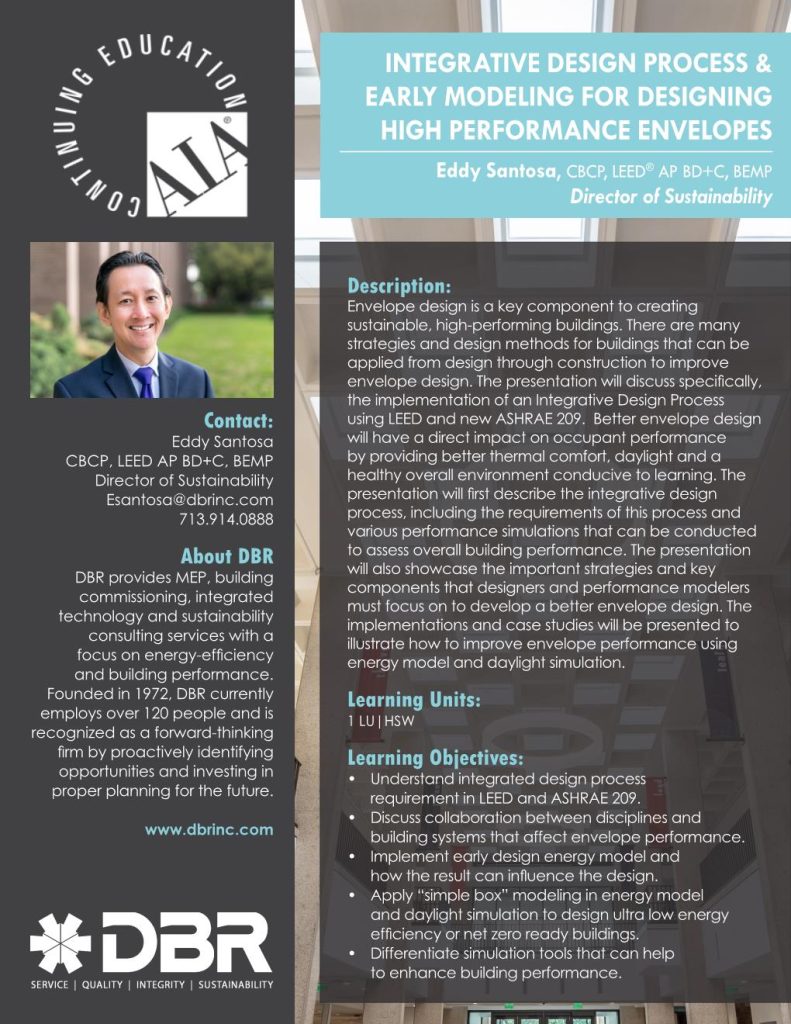
May 2nd, 2018 by Eddy Santosa, CBCP, LEED AP BD+C, BEMP
DBR is pleased to announce we are now a registered AIA Continuing Education Provider for the design and building industry to assist AIA members needing continuing education to stay at the top of their field. At this time DBR offers two presentation opportunities for continuing education and we are ready to provide lunch and learn opportunities to you and your staff!
 Integrative Design Process and Early Modeling for Designing High Performance Envelope
Integrative Design Process and Early Modeling for Designing High Performance Envelope
Envelope design is a key component to creating sustainable, high-performing buildings. There are many strategies and design methods for buildings that can be applied from design through construction to improve envelope design. The presentation will discuss specifically, the implementation of an Integrative Design Process using LEED and new ASHRAE 209. Better envelope design will have a direct impact on occupant performance by providing better thermal comfort, daylight and a healthy overall environment conducive to learning. The presentation will first describe the integrative design process, including the requirements of this process and various performance simulations that can be conducted to assess overall building performance. The presentation will also showcase the important strategies and key components that designers and performance modelers must focus on to develop a better envelope design. The implementations and case studies will be presented to illustrate how to improve envelope performance using energy model and daylight simulation.
Learning Units:
1 LU|HSW
Learning Objectives:
• Understand integrated design process requirement in LEED and ASHRAE 209.
• Discuss collaboration between disciplines and building systems that affect envelope performance.
• Implement early design energy model and how the result can influence the design.
• Apply “simple box” modeling in energy model and daylight simulation to design ultra low energy efficiency or net zero ready buildings.
• Differentiate simulation tools that can help to enhance building performance.
Download Flyer Below:
Integrative Design Process & Early Modeling for Designing High Performance Envelopes
 Greening & Delivering High Performance Buildings
Greening & Delivering High Performance Buildings
Delivering and designing sustainable and high-performance buildings are becoming a norm and necessity in each project. It is not only because of code requirements but due to the benefits for the building owner and occupants over the long term. To develop sustainable and high-performance buildings, there are 3 core values that we need to implement to develop successful sustainable projects such as an integrative and collaborative approach; innovative and creative solutions; and cost and environmental impact. These core values will optimize and enhance building performance delivery and design. To implement core values, the presentation provides some case studies and examples. The implementations consist of three major steps. The first step will focus on early design impact and the second step will be during construction document and administration. The last step will discuss implementation or strategies in existing buildings.
Learning Units:
1 LU|HSW
Learning Objectives:
• Apply sustainability approaches during the design process.
• Discuss collaboration effort to achieve successful sustainable buildings.
• Implement knowledge based design in the design process.
• Differentiate simulation tools that can help to enhance building performance.
Download Flyer Below:
Greening & Delivering High Performance Buildings
Contact:
Eddy Santosa, CBCP, LEED AP BD+C, BEMP
Director of Sustainability
[email protected]
713.914.0888
